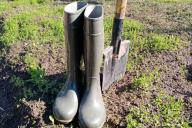Gardeners widely use green manure plants for the benefit of their plots.
The use of green manure is a simple, convenient and effective way to improve the structure and composition of the soil, as well as to destroy phytopathogens.
Most summer residents use green manure in the second half of summer or in autumn. They are used less frequently in spring.
But this tactic is not always correct, since there is a lot of time left before planting heat-loving vegetable plants, and the land is empty and overgrown with weeds until about mid-May.
Green manure is sown precisely in order to enrich the soil with nutrients and give plants an excellent start.

What to choose
1. The list of cold-resistant green manure crops includes winter rye and oats. They can be sown from mid-March.
2. Starting from the second ten days of April, oilseed radish, mustard, and barley become available.
3. If time is very short, but you still want to sow green manure, you can use cress. The shoots will not take long to appear.
However, it is worth considering what plants will be planted after green manure. For example, you should not sow cruciferous green manure if you plan to sow cabbage in this area.
How to seal
As soon as the green manure plants grow up, they need to be cut. Use a flat cutter or a hoe for this.
It is acceptable to slightly dry them out and then bury them in the soil for subsequent mineralization. Weather conditions at the end of May contribute to the rapid decomposition of the remains of green manure.








